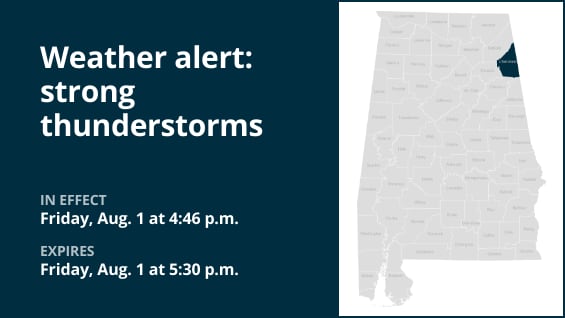At 4:46 p.m. on Friday, the National Weather Service issued a weather notice for Cherokee County, warning of heavy thunderstorms through 5:30 p.m.
Up to 40 mph wind gusts are possible for locals.
The meteorological service said that “a strong thunderstorm was tracked by Doppler radar at 4:45 p.m. moving south at 15 mph over Western Weiss Lake, or near Centre.” “Gusty winds could knock down tree limbs and blow around unsecured objects.”
Forney, Leesburg, Sand Rock, Gaylesville, Tennala, Slackland, Cherokee Rock Village, Pleasant Gap, Cornwall Furnace Park, Western Weiss Lake, Eastern Weiss Lake, Moshat, Ball Flat, Coloma, Weiss Dam, Fullerton, and Yellow Creek Falls are among the locations affected by the alert.
The weather service remarks, “If you’re outside, think about taking cover inside a structure. Alongside this storm is torrential rain, which could cause localized flooding. Avoid operating a car on flooded roads. This storm is causing frequent lightning strikes from the clouds to the ground. Ten miles can separate a thunderstorm from a lightning strike. Look for a secure place to hide inside a building or car.
Shielding yourself from approaching lightning: Expert safety guidelines
Approximately 25 million lightning strikes occur in the United States annually, most of which take place in the summer. The weather service reports that lightning is the cause of death for about 20 persons each year. As thunderstorms get closer, the risk of lightning increases; it peaks when the storm is directly overhead and then progressively decreases as it passes.
Think about the following suggestions to make sure you’re safe during a thunderstorm.:
Plan for lightning safety:
-
When venturing outdoors, it’s vital to establish a clear plan for seeking shelter in case of lightning.
-
Monitor the sky for threatening signs and listen for the sound of thunder. If thunder is audible, it’s an indication that lightning is nearby.
-
Seek a safe place to shelter, preferably indoors.
Indoor safety precautions:
-
Once you’ve found shelter indoors, abstain from using corded phones, electrical appliances, or plumbing fixtures, and refrain from approaching windows and doors.
-
Lightning can follow conductive pathways, and these precautions reduce the risk of electrical surges.
Hold off till the all-clear:
-
After the last lightning strike or thunderclap, wait at least 30 minutes before resuming outdoor activities.
-
It’s important to remember that lightning can strike even when a storm seems to have passed, so exercise caution.
When there is no indoor shelter:
Take these precautions to increase your safety if you are outside during a thunderstorm without access to indoor shelter:
-
Avoid open fields, hilltops, or ridge crests, as they expose you to greater lightning risk.
-
Steer clear of tall, isolated trees and other prominent objects. In forested areas, stay close to lower stands of trees.
-
If you’re with a group, ensure individuals are spread out to prevent lightning current from transferring between people.
-
Camping in an open setting during a thunderstorm is strongly discouraged. If you have no alternative, set up camp in a valley, ravine, or other low-lying areas. It’s crucial to note that a tent provides no protection against lightning.
-
Do not approach water bodies, wet objects, or metal items. While water and metal don’t attract lightning, they conduct electricity effectively and can pose significant risks.
In conclusion, being alert and ready are your best defenses against lightning threats. You may put your safety first and drastically lower the likelihood of lightning-related mishaps by adhering to these rules.
Mastering wet roads: Safety tips for heavy rainfall
If heavy rainfall persists or if runoff is substantial, flooding may result. Saturated soils and/or heavy rainfall can cause excessive runoff. To keep safe during periods of intense rain, heed these weather service recommendations:
Watch out for flooding rivers:
When it rains a lot, stay clear from parking or strolling near culverts or drainage ditches since the swift-moving water could carry you away.
Keep your distances from other vehicles safe:
Keep a safe distance from the automobile ahead of you by following the two-second rule, and give yourself an extra two seconds if it’s raining a lot.
Reduce your speed and drive carefully:
Lowering your speed is essential on wet roads. To prevent skidding, gently release the gas pedal and refrain from applying sudden braking.
Pick your lane carefully:
Water tends to pool in the outside lanes, so stick to the central ones.
Visibility is important.
As rain-spattered windows make it more difficult to see other vehicles, turn on your headlights and pay attention to those in blind spots and behind you.
Be cautious on slick roads:
Roads are slickest during the first half-hour of rain because of a combination of rain, oil, and filth. Be especially careful during this time.
Stay a safe distance away from big cars:
Avoid following buses or big vehicles too closely. Their big tires produce a mist that blurs your eyesight. Additionally, be cautious when passing them; if you have to, pass swiftly and securely.
Be mindful of your wipers:
The wiper blades may be overloaded by heavy rain. It’s time to stop and wait for the rain to stop when visibility is so poor that you can’t see other cars or the road’s borders from a safe distance. Stopping at rest areas or other sheltered spaces is the best option.
If you can’t avoid the roadside, pull off as far as you can, ideally past the end of a guard rail, and wait for the storm to pass. To let other cars know where you are, turn on your emergency flashers and keep your headlights on.
You may greatly lower dangers and protect your health when it rains a lot by adhering to these safety precautions. To ensure a safe and sound voyage, keep yourself updated on weather conditions and follow local authorities’ instructions.
United Robots offers a service called Advance Local Weather Alerts that gathers the most recent information from the National Weather Service using machine learning.






